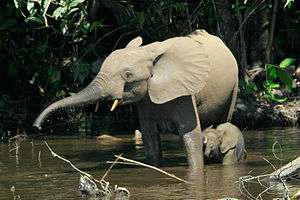Douala Edéa Wildlife Reserve
| Douala Edéa Wildlife Reserve | |
|---|---|
|
IUCN category IV (habitat/species management area) | |
|
Gymnosiphon longistylus, Douala-Edea Reserve | |
| Nearest city | Edéa |
| Coordinates | 3°33′0″N 9°46′0″E / 3.55000°N 9.76667°ECoordinates: 3°33′0″N 9°46′0″E / 3.55000°N 9.76667°E |
| Area | 1,600 square kilometres (620 sq mi) |
| Established | 1932 |
The Douala-Edéa Wildlife Reserve is a wildlife reserve in the Littoral Region of Cameroon. It is located on either side of the mouth of the Sanaga River along the shores of the Bight of Biafra opposite the island of Bioko.[1]
History and location
The reserve was established in 1932. As of 2000, it covered 160,000 hectares (400,000 acres).[2] Cameroon designated the reserve as a wildlife park for scientific purposes in 1971, and by 1974 the reserve had a conservator and guard post. Upgrade to full national park status was delayed since oil had been discovered in Cameroon's coastal areas, and the area could hold important reserves.[3] Lake Tissongo, a lagoon connected to the south bank of the Sanaga river by a 5 kilometres (3.1 mi) tidal channel, is included in the reserve.[4] Mouanko is the main town in the reserve, on the north shore of the Sanaga River.[5]
Flora
80% of the reserve is covered by tropical lowland equatorial forest, and 15% by Atlantic mangrove forests.[5] The Mouanko reserve between the Sanaga and the Wouri estuary holds about 15,000 hectares (37,000 acres) of mangrove forests.[4] The mangroves form a buffer against coastal erosion, and are a refuge for 80% of the local marine and aquatic species for at least part of their lifecycle. They are threatened by logging for construction timber and for firewood used in fish smoking, as well as by urban infrastructure development.[6] Illegal loggers were expelled from the park in 1976.[7]
Fauna

Fauna include forest elephants, primates (chimpanzees, monkey species such as black colobus), antelopes (sitatunga, blue duiker, etc.), West African manatees, sea turtles, dolphins, crocodiles, alligator, many fish species, terrestrial and water bird species.[5] The red-capped mangabey was reported to be common in the reserve in 1972.[8] The endangered red-eared nose-spotted guenon was reported in the Lombé part of the reserve in densities of 2-3 groups per square kilometers, but populations had dropped elsewhere due to hunting.[9] Animals in the reserve are poorly protected and poaching is widespread.[4] Central chimpanzees in the reserve are threatened by hunters.[10]
References
- ↑ Douala Edea - WDPA.
- ↑ Weiss & Jacobson 2000, pp. 447.
- ↑ Weiss & Jacobson 2000, pp. 447-448.
- 1 2 3 Cameroon - Ramsar.
- 1 2 3 Ngea 2010.
- ↑ Protection - UNFCCC.
- ↑ Lee 1988, pp. 18.
- ↑ Lee 1988, pp. 17.
- ↑ Lee 1988, pp. 71.
- ↑ Caldecott & Miles 2005, pp. 307.
Cited sources
- Weiss, Edith Brown; Jacobson, Harold Karan (2000). Engaging countries: strengthening compliance with international environmental accords. MIT Press. ISBN 0-262-73132-0.
- Caldecott, Julian Oliver; Miles, Lera (2005). World atlas of great apes and their conservation. University of California Press. ISBN 0-520-24633-0.
- "Cameroon" (PDF). Ramsar Wetlands. Retrieved 2011-03-01.
- "Douala Edéa Wildlife Reserve". World Database on Protected Areas. Retrieved 2011-03-01.
- Lee, Phyllis C. (1988). Threatened Primates of Africa: The Iucn Red Data Book. IUCN. ISBN 2-88032-955-8.
- Ngea, Peter (October 19, 2010). "Douala – Edea Reserve: the last refuge of hope for man and nature (Part 2)". EnviroMend. Retrieved 2011-03-01.
- "Protection of Cameroon estuary mangroves through improved smoke houses" (PDF). United Nations Framework Convention on Climate Change. 01/07/2010. Retrieved 2011-03-01. Check date values in:
|date=(help)